2023-2024
Harvard Sustainability Report
How we are accelerating action toward a healthy, sustainable, fossil fuel-free future.

A message from Harvard’s Chief Sustainability Officer
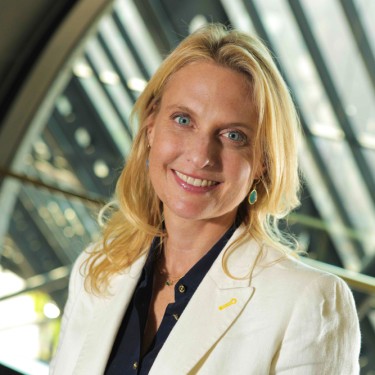
Harvard is leveraging its research and thought leadership to address climate change and sustainable development. The Office for Sustainability works closely with faculty, students, staff, and alumni, using our urban campus as a testbed to translate research, knowledge and innovation into practice and pilot solutions.
Last year, we shared the University’s updated Sustainability Action Plan which outlines an inclusive and comprehensive institutional vision and framework for advancing and scaling action with a lens of climate, equity, and health. The Plan details Harvard’s university wide sustainability goals, leading-edge operational standards, priorities, and strategies for accelerating action through its campus and its operations.
To track Harvard’s goals more comprehensively, and our progress against them, we defined four pillars under which this work primarily falls: How We Power, How We Build, How We Operate, and How We Lead. You will find that this Annual Report reflects this framework, highlighting sustainability solutions and achievements from the past year in each of these four defining areas.
Explore the Report
How We Power
Harvard’s holistic Sustainability Action Plan includes our climate goals, which focus on climate, health and equity: Goal Zero, to be Fossil Fuel-Free by 2050, as well as Fossil Fuel-Neutral by 2026. We also have two goals focused on reducing our value-chain (or Scope 3) emissions, which include: 1. Avoiding embodied carbon in major capital projects by a minimum of 20%, and 2. Reducing our food-related emissions by 25% by 2030.

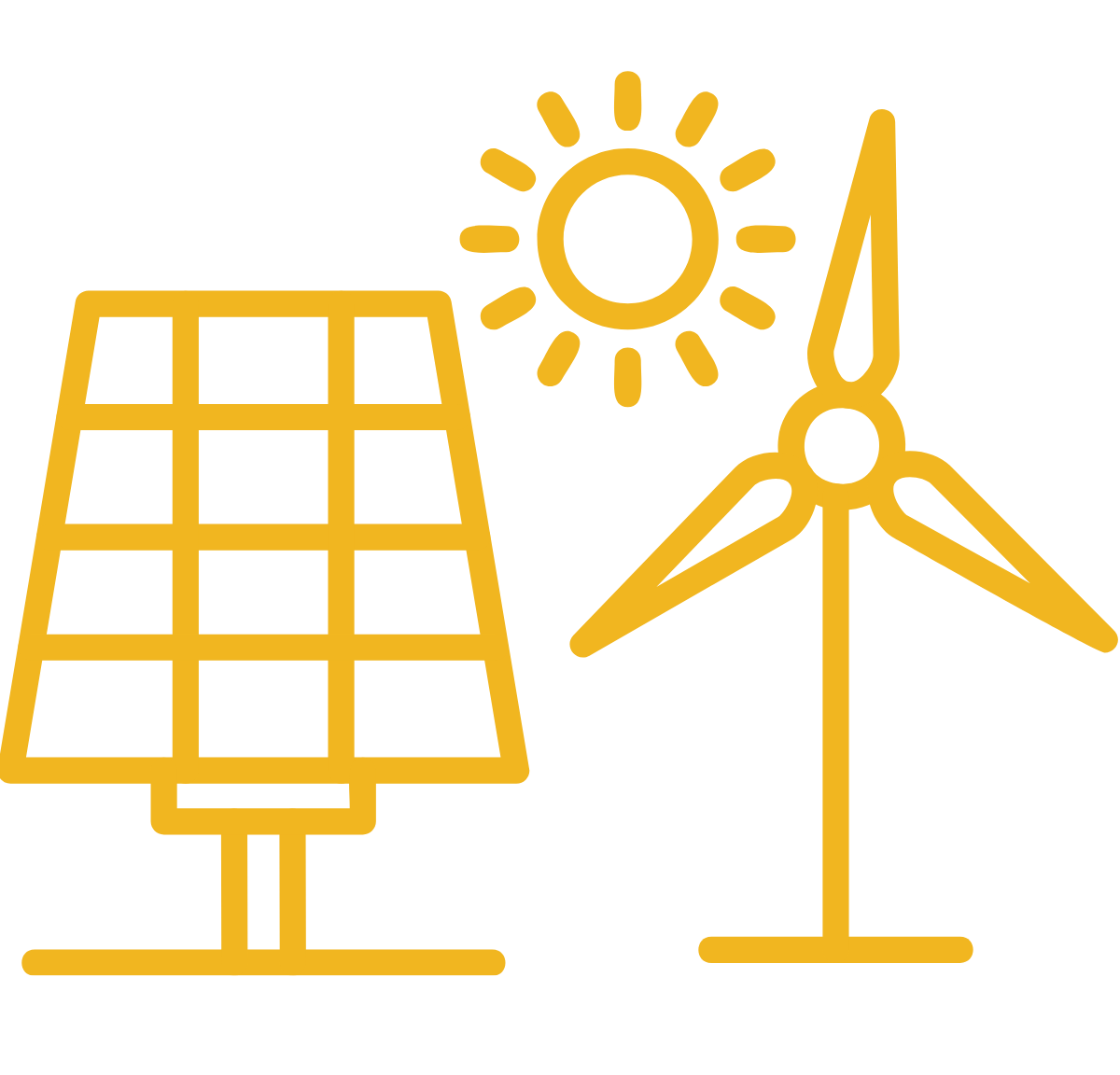
100% renewable energy

3 MW of on-site solar
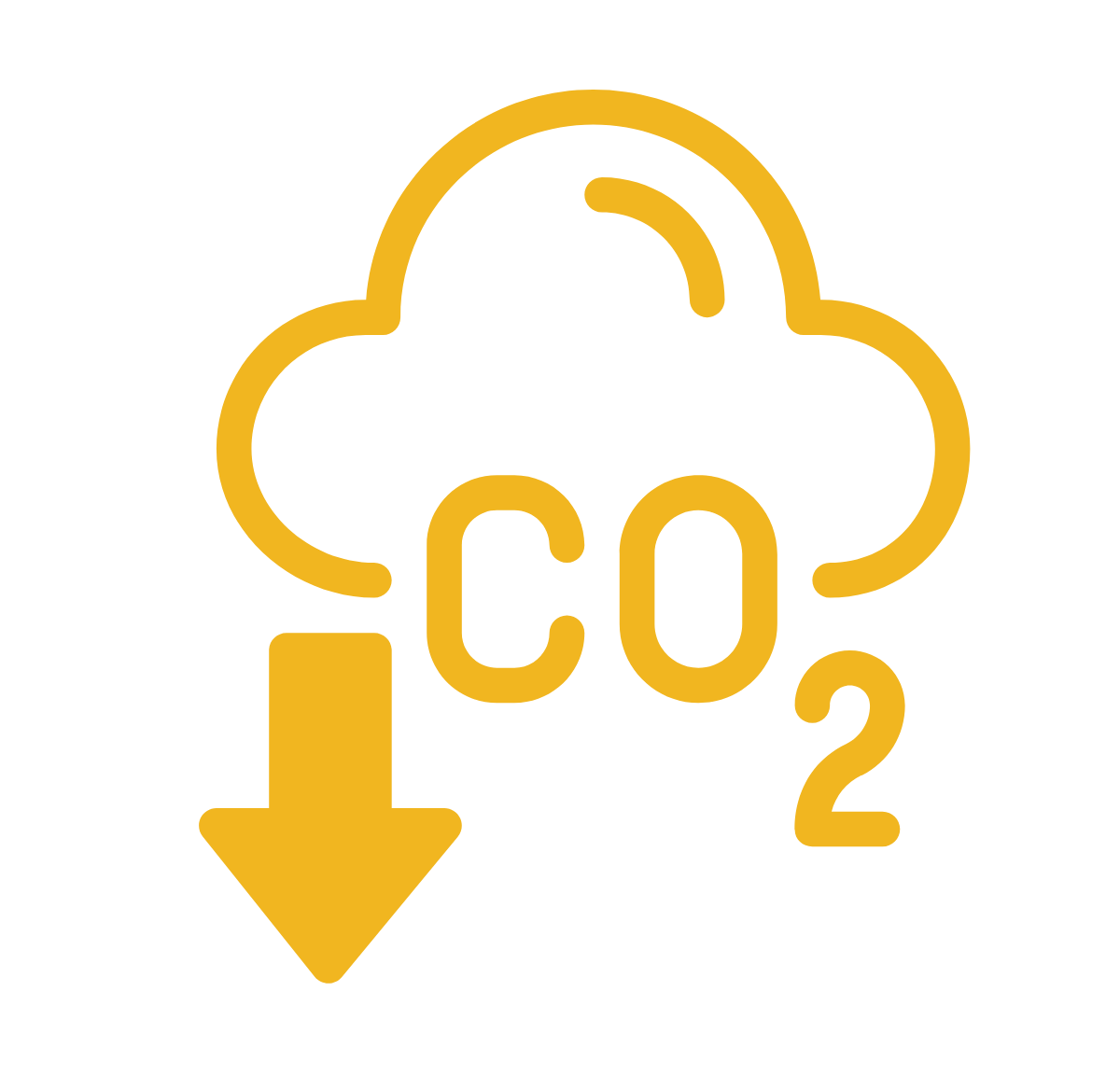
40% decrease in carbon emissions per sq. ft., 2006-2023
Goal Zero
Fossil Fuel-Free by 2050
In 2018, Harvard set a goal to be Fossil Fuel-Free by 2050. Known as Goal Zero, this target is focused on eliminating the use of fossil fuels in Harvard’s buildings and vehicles, as well as the negative health impacts they cause.
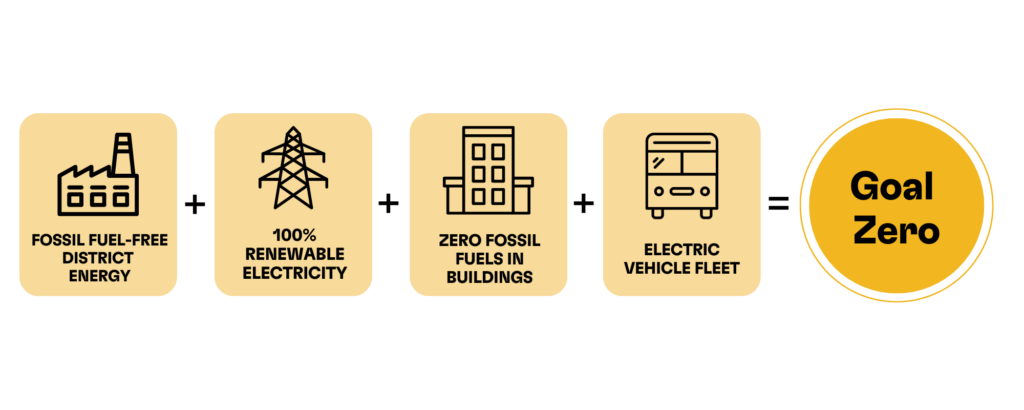
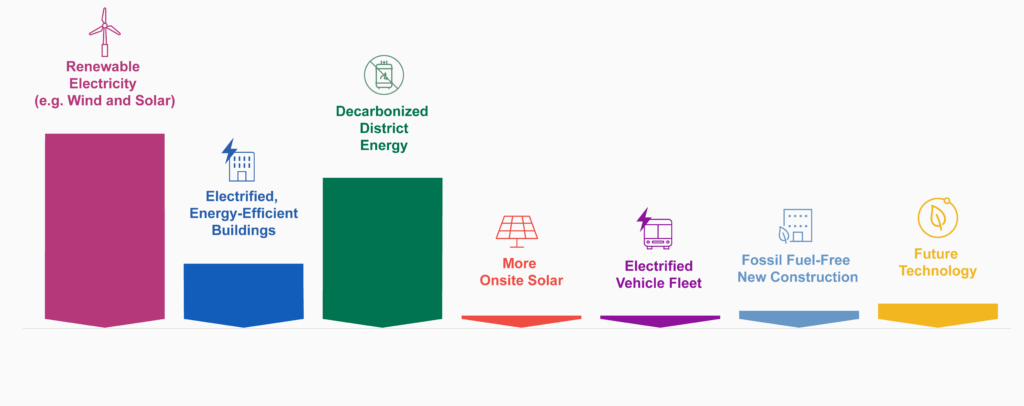
Harvard is working to procure renewable electricity, decarbonize our central heating plants, electrify our historic campus buildings and our vehicle fleet, invest in on-site solar, and ensure all new construction is designed to rely on non-fossil fuel energy.
Fossil Fuel-Neutral by 2026
As a bridge to reach Goal Zero, Harvard has a short-term objective to be Fossil Fuel-Neutral by 2026. This means Harvard will zero out campus emissions (Scope 1 and Scope 2) by funding projects that zero out both greenhouse gas emissions and the health impacts from our use of fossil fuels, such as those caused by air pollution.
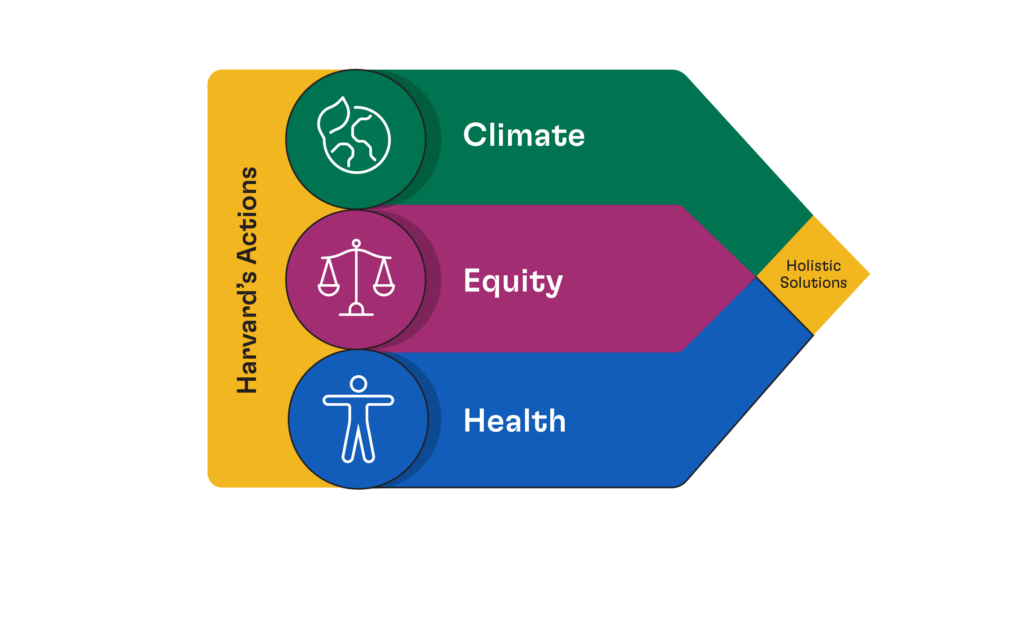
Energy Spotlights
How We Build
Through sustainable design, construction, sourcing, and operation of our buildings and landscapes, we aim to address the climate crisis, enhance health and equity throughout the value chain, and improve quality of life on campus.

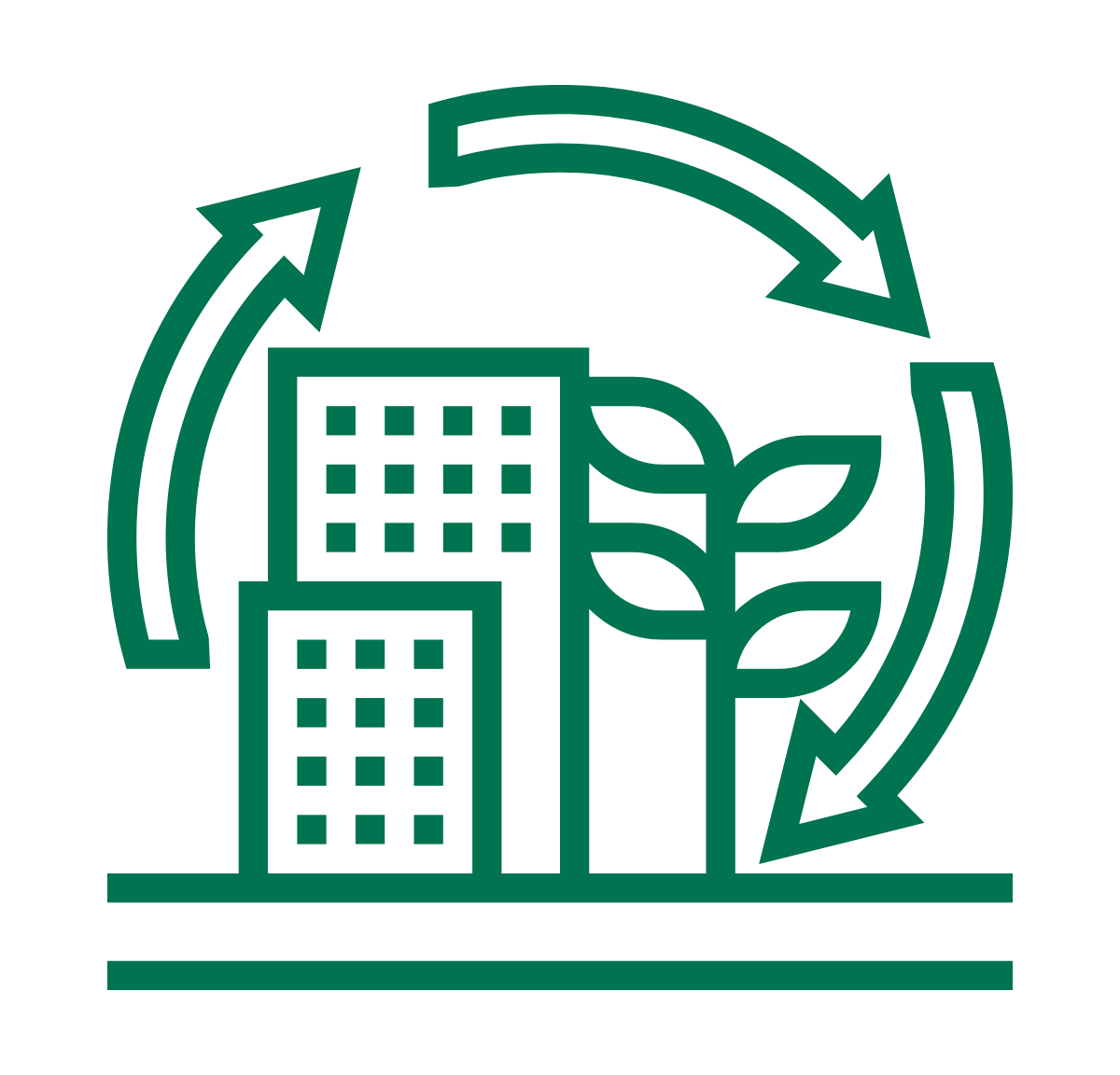
50+ capital projects, 5M+ sq. ft. of real estate

2 mass timber projects under construction
Source: David Rubenstein Treehouse Conference Center rendering by StudioGang

14 interior product categories

12 UBEs (Underrepresented Business Enterprises)
Building for a Better Future
As part of Harvard University Sustainable Building Standards, the Harvard Healthier Building Academy informs how teams are designing and renovating campus buildings that are healthier for people and the planet.
19th Century Harvard Properties Renovated to Meet Sustainable Certifications (PHIUS+ and ILFI LBC Core)
Two historically significant buildings, 5 Sacramento Street and 13 Kirkland Place, were gut renovated in 2024 to be all-electric and designed to meet: the Living Building Challenge (LBC) Core certification by the International Living Future Institute (ILFI) and PHIUS (Passive House Institute US) certification standards.
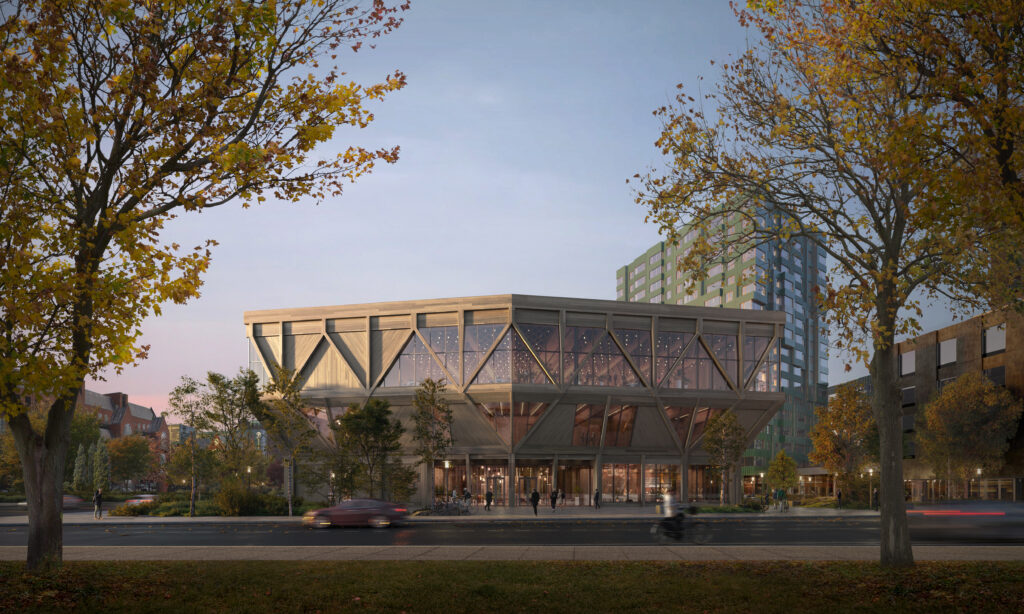

Sustainable Design at Harvard
David Rubenstein Treehouse
The David Rubenstein Treehouse will be a leading example of holistic sustainability performance addressing climate, health and equity.
- The building will be all-electric on site, including a commercial kitchen and a 67 kW solar PV system estimated to generate 78 MWh of renewable electricity per year.
- The project has also been designed to reduce embodied carbon ~55% per the design through use of a mass timber structure, low embodied carbon insulation, glazing and low embodied carbon concrete in the foundation and building structure without the use of fly ash – a first in Massachusetts.
- Instead of fly ash (a toxic by-product of burning coal), Ground Glass Pozzolan (a recycled glass product) has been used in structural and non-structural concrete as an innovation to find more long-term sustainable, healthier solutions for concrete.
- The building’s roof and bioswales will also be used to harvest rainwater for irrigation and toilet flushing.
- The project is striving to achieve Living Building Challenge Core certification and will exceed Harvard’s Healthier Building Academy for going beyond the required 14 product categories.

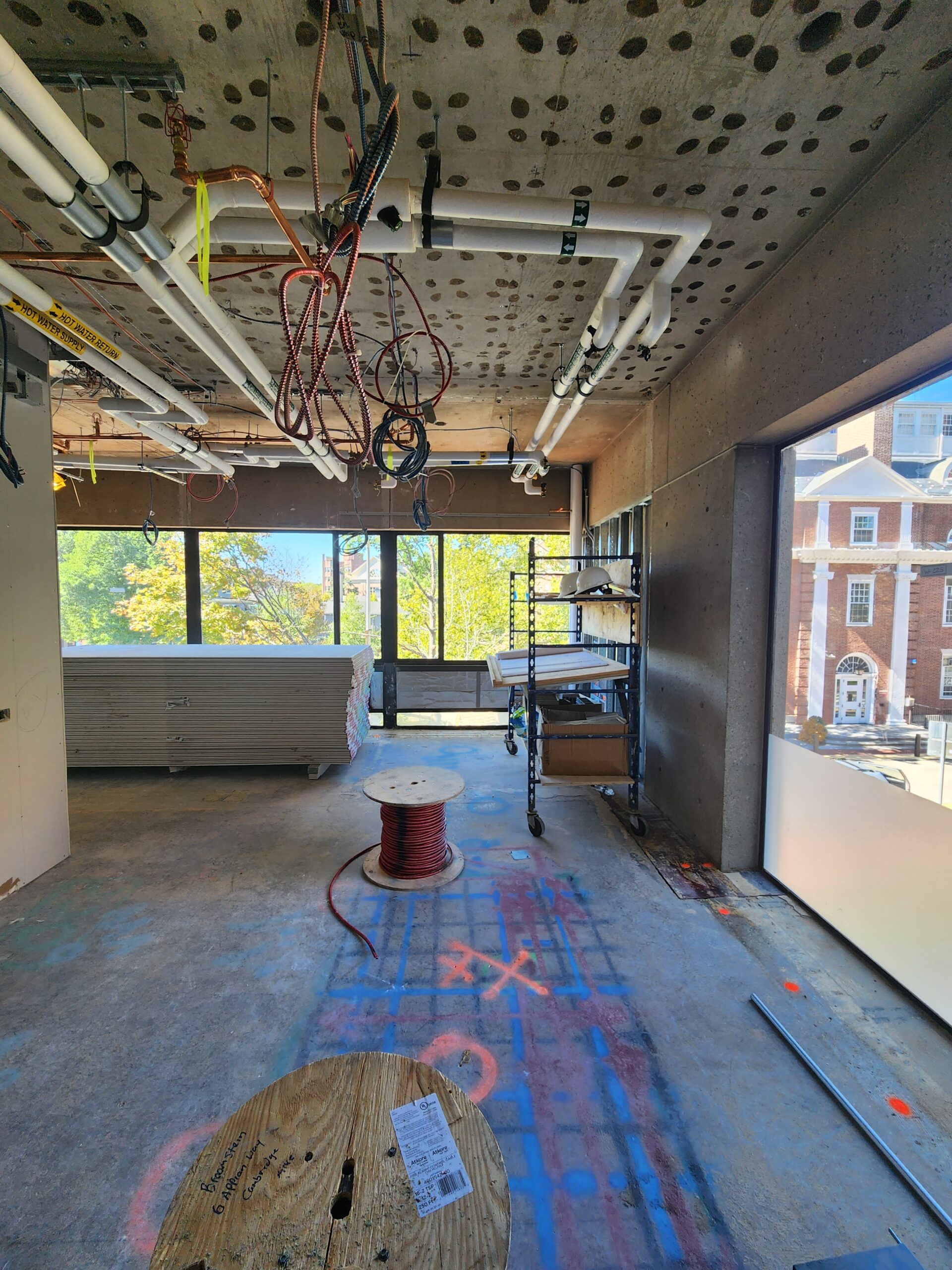
2024 Renovation of the Harvard Graduate School of Educations’ Gutman Library
The renovation of the Gutman Library’s 1st and 2nd floors was a three-phase project completed in January 2024 that brought the core student-facing services all under one roof. Gutman Library has long been the heart of GSE, with the Gutman Commons Café and the Gutman Conference Center providing space for our community and visitors, to gather, collaborate and learn. This most recent project brought the Office of Student Affairs, the Career and Alumni Engagement offices, and Academic Programs administrative staff to the fully renovated 2nd floor and created a new home for Admissions and Financial Aid on the 1st floor. Along with the aim of strengthening the student experience, this project prioritized sustainability. Here are a few of those highlights:
- The new HVAC system includes chilled beams and is occupancy-controlled.
- The new LED lighting system has daylight sensing and occupancy sensors.
- The new and renovated toilet rooms have low-flow fixtures.
- The offices are unassigned (that is, not assigned to individual staff members) so that more people can utilize the same space in this era of hybrid work when some staff are working remotely on any given day.
- There is a variety of workspaces and seating options for more comfort while working.
- The space has two large living walls and plants in the space.
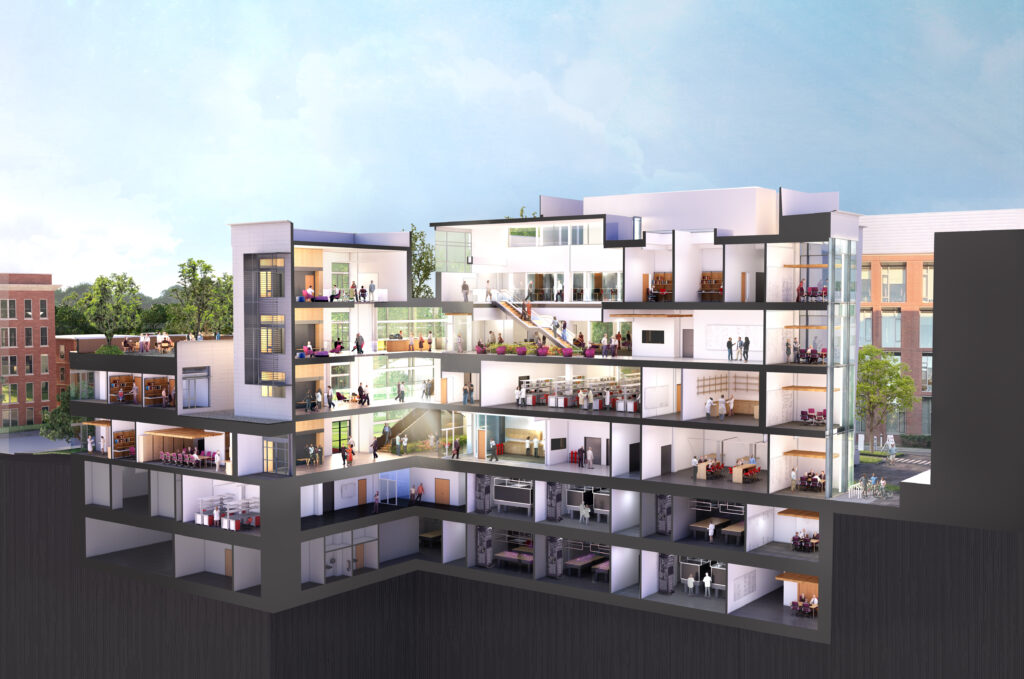
Goel Quantum Science and Engineering Building at 60 Oxford St.
The Goel Quantum Science and Engineering Building, situated at 60 Oxford Street in Cambridge, stands as a cutting-edge facility offering advanced education and fostering collaboration to support a new generation of innovators. Embodying that collaborative spirit, the project team worked closely and is striving to meet The Living Building Challenge Core and Materials Petal certifications as well as the stringent class-based elimination of chemicals of concern criteria as outlined by the Harvard Healthier Building Academy.
During the design and early construction phases, efforts were made to design products that did not align with the project’s goals. Engaging in manufacturer outreach, each product underwent thorough vetting to ascertain its alignment with the project’s healthier materials objectives, striving to find the healthier, best-in-class option for each product type.
- Over 2,500 products were researched for this project
- 1,078 products were used in the final construction, with the vast majority either approved as Compliant (34%) or as Best-In-Class (62%).
- Over 650 manufacturers received advocacy for more transparency and the elimination of chemicals of concern.
- 37 Harvard Healthier Building Academy-approved products were installed.
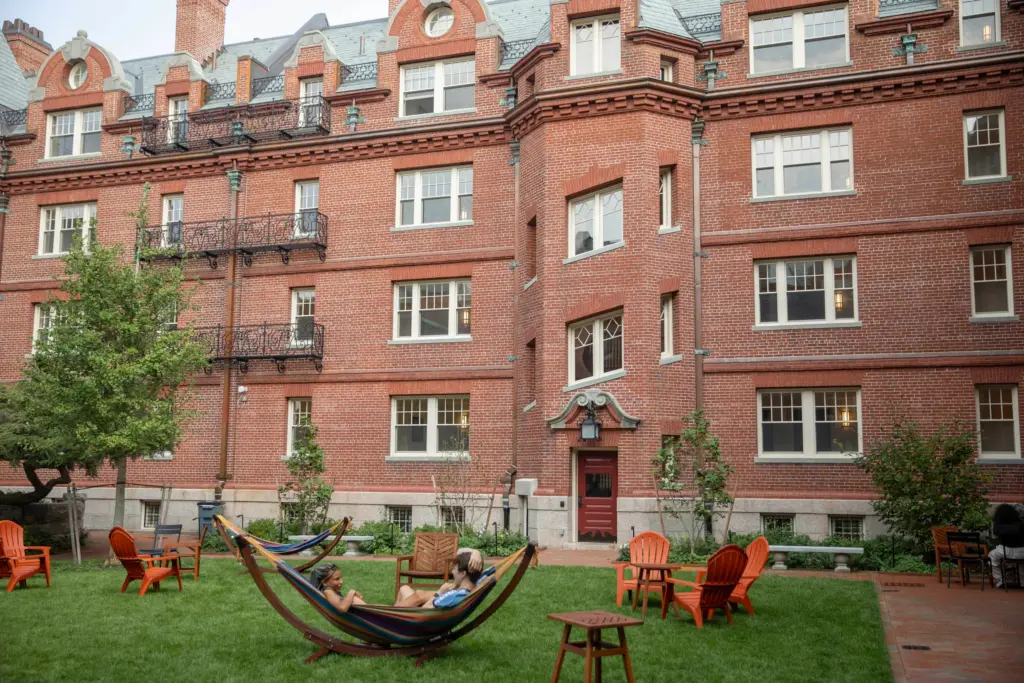
Second Phase of Adams House Complete
In 2023, the re-opening of Randolph Hall marked the completion of the second phase of Adams House renewal, a multiyear project being done in three phases to update all six buildings in Adams House to provide new and expanded spaces and amenities, improve accessibility, and increase sustainability. Phase I, completed in 2021, focused on Claverly Hall and also included an update of Apthorp House.
The Randolph Hall project (Phase II) achieved LEED-Gold certification in January 2024. Sustainability highlights of the project included:
- Full replacement of building systems for energy efficiency including energy recovery
- Insulated walls and high-performance window replacements to improve building envelope performance
- Low-flow water fixtures
- Enhanced indoor air quality strategies, including ducted fresh air to student bedrooms
- Achievement of Harvard Healthier Building Academy interior materials, reuse of existing building fabric
The third and final and final phase of the project, which includes Russell Hall, the library commons, and Westmorely Court, is currently underway and expected to be complete by next summer.
How We Operate
Harvard is accelerating new systems that enable healthier, low-carbon living—creating systems that can be scaled and adopted more broadly. By developing new systems and practices, we are modeling sustainable operations that can lead to healthier, more equitable communities. We have Sustainability Standards for Harvard’s operational areas: food, IT, landscaping, cleaning, and more.

Explore: Scope 3 Emissions, Transportation, Food, Waste, Water, Landscaping

~220K lbs. CO2 emissions averted due to EV buses

2 University-wide Scope 3 goals

20K fewer beef burgers

2 million gallons of water saved
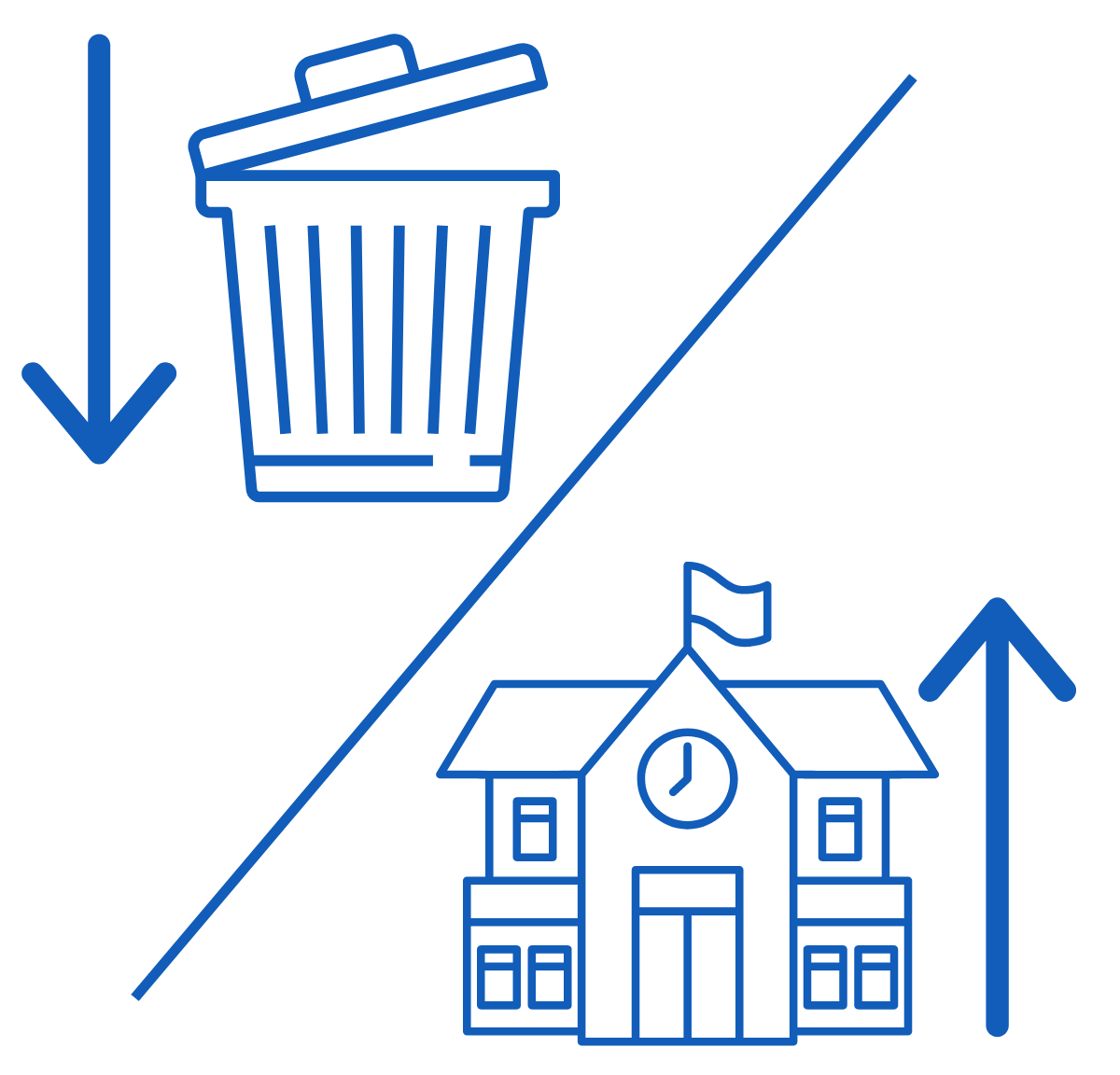
Decline in waste despite 16% growth of campus sq. footage
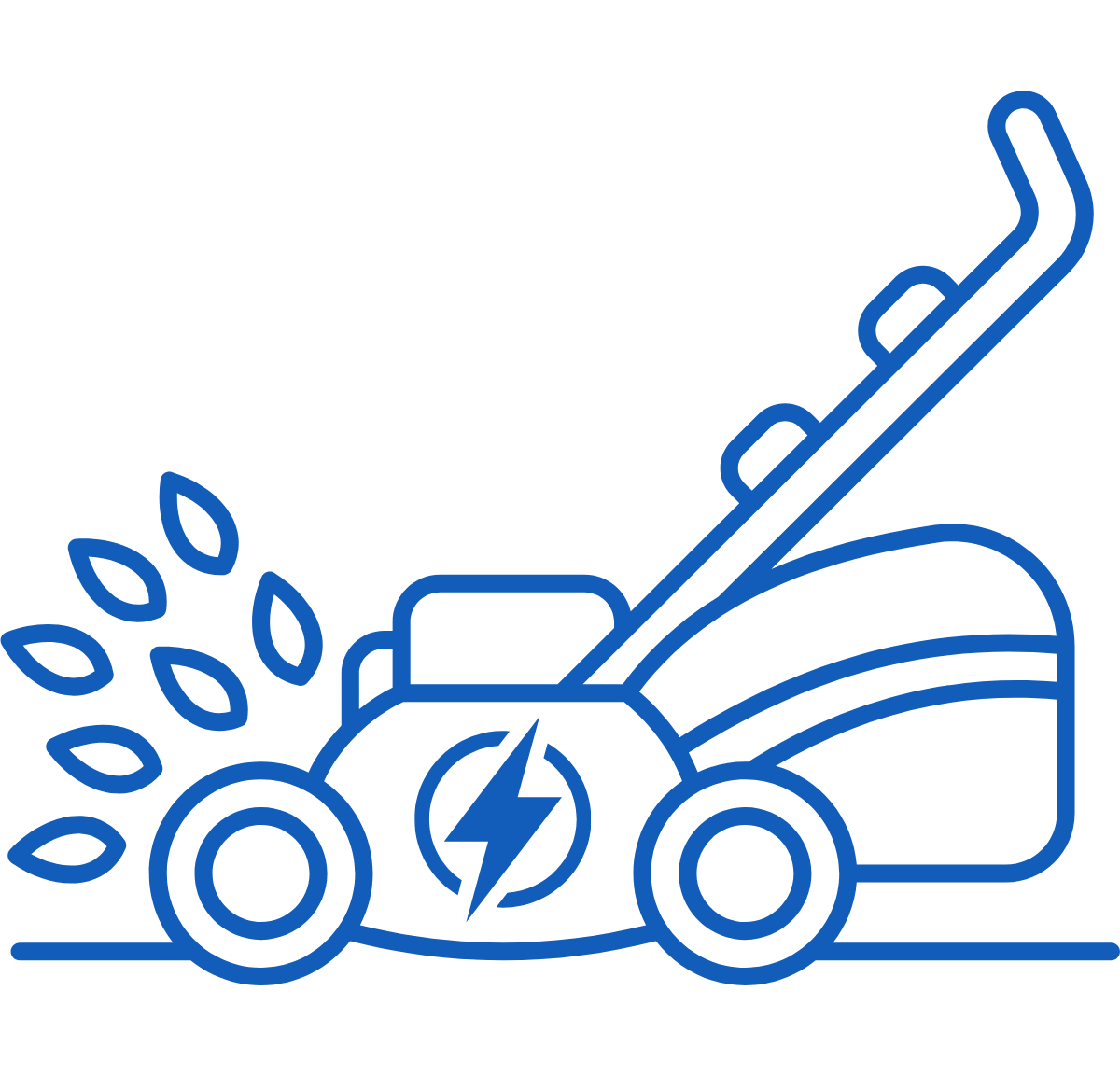
47 pieces of electric equipment
Reducing Scope 3 Emissions
In 2023, Harvard published a new Scope 3 Emissions webpage. This new page explores the University’s strategy to address Scope 3 emissions, which are indirect “value chain” emissions that the GHG Protocol classifies into 15 broad categories related to upstream and downstream activities. For most organizations, including Harvard, Scope 3 emissions are far larger than Scope 1 and 2 emissions combined. Harvard is prioritizing action on six priority Scope 3 categories: embodied carbon in construction, food, air travel, commuting, IT, and other purchased goods/services. Learn more.
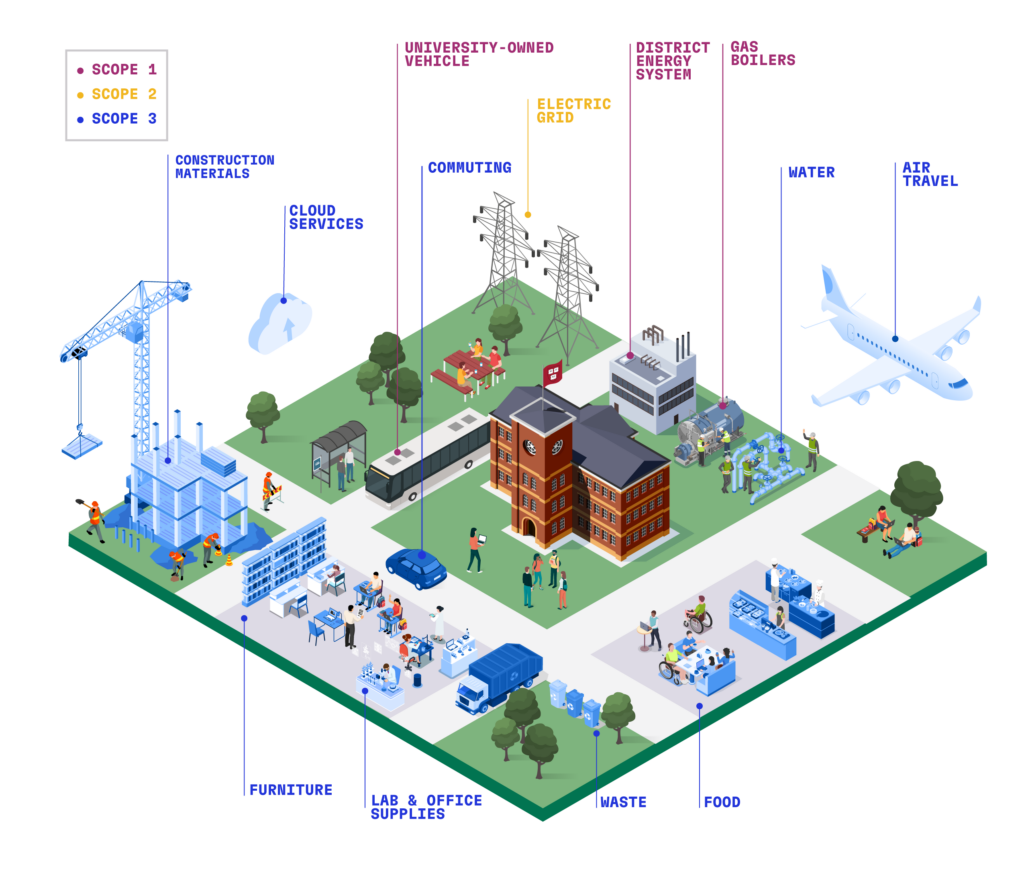
SUSTAINABLE TRANSPORTATION SWAPS
Electric Vehicles at Harvard
As part of its mission toward Goal Zero, Harvard purchased four electric shuttle buses and continues to replace University vehicles with all-electric vehicles. Since the electric shuttles came online in 2021, Harvard has purchased 10+ new EVs, including mail trucks, box trucks, vans, parking vehicles, and utility vehicles.
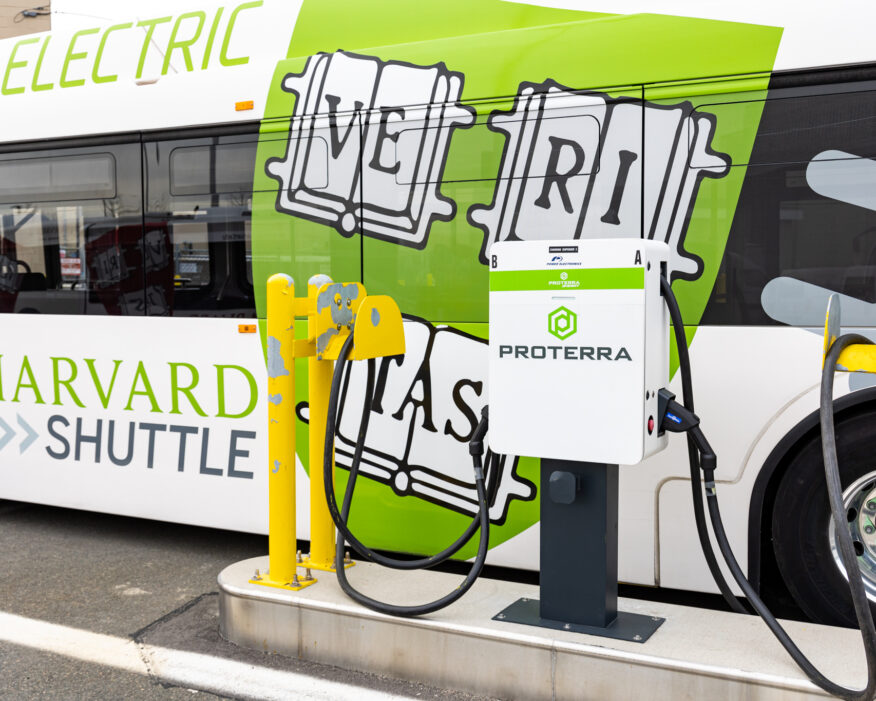
HARVARD TRANSPORTATION
Sustainable Commuting

108,341 Bluebike trips
Source: COMMUTERCHOICE 2023 YEAR IN REVIEW

$3.2 million public transportation subsidy with 54,849 monthly MBTA passes
Source: COMMUTERCHOICE 2023 YEAR IN REVIEW

42% increase in EV charging access by Parking Services
Source: COMMUTERCHOICE 2023 YEAR IN REVIEW
SINCE 2019
Coolfood Pledge
As an inaugural signatory to Coolfood, Harvard aims to:
- Reduce greenhouse gas emissions (GHG) from food by 25% by 2030
- Reduce per-plate emissions by 38% by 2030
- Simultaneously enable and support sustainable food systems
- Reduce wasted food

Food Sustainability at Harvard

15,154 pounds of food donated
Source: Food for Free

55,550 lbs. of tofu served
Source: HUDS Learning Report 2023

200% increase in plant & chicken option over beef
Source: HUDS Learning Report 2023
Sustainable & Healthful Dining
HARVARD’S GOAL
A Zero-Waste Future
The new Waste Stewardship Working Group unites 40+ Harvard staff members to strategize solutions toward a Zero-Waste future.
Sustainable Landscaping
- Harvard is investing in battery-operated, electric landscaping equipment, including battery chainsaws, push mowers, blowers, string trimmers, and an electric Ford transit van for power washing.
- Across the University, landscaping crews are prioritizing native planting. Harvard Kennedy School local planted pollinator-friendly flowers like cone flowers, asters, lavender and bee balm. The University has also begun piloting rewilding spaces around campus. At Harvard Business School, a small grass area in the center of a parking lot was rewilded in spring 2023 as part of a FAS course, HIST 1973: Re-wilding Harvard, with help from HBS Operations, Reed Hilderbrand Landscape Architecture, and Cambridge Landscaping.
How We Lead
Harvard’s world-class faculty, researchers, and staff are prioritizing sustainability through important academic research and teaching, as well as projects and ventures that explore innovative sustainable solutions that can be piloted on our campus and scaled locally and globally to address climate action.


100+ OFS-funded student grants
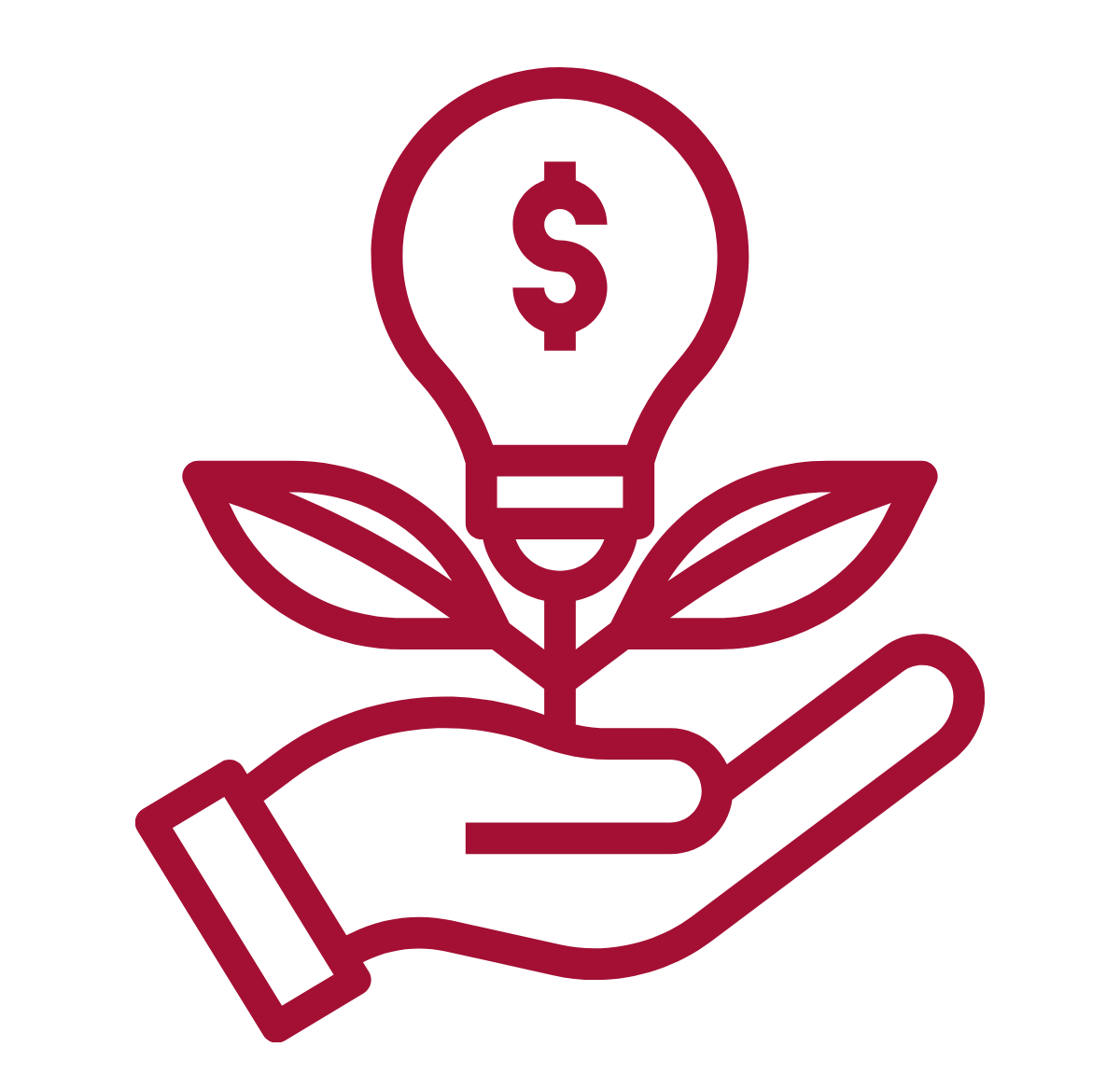
$8.1M+ supporting research by Salata Institute
Source: Salata Impact Report | March 2024

220 courses about climate change, energy, sustainability
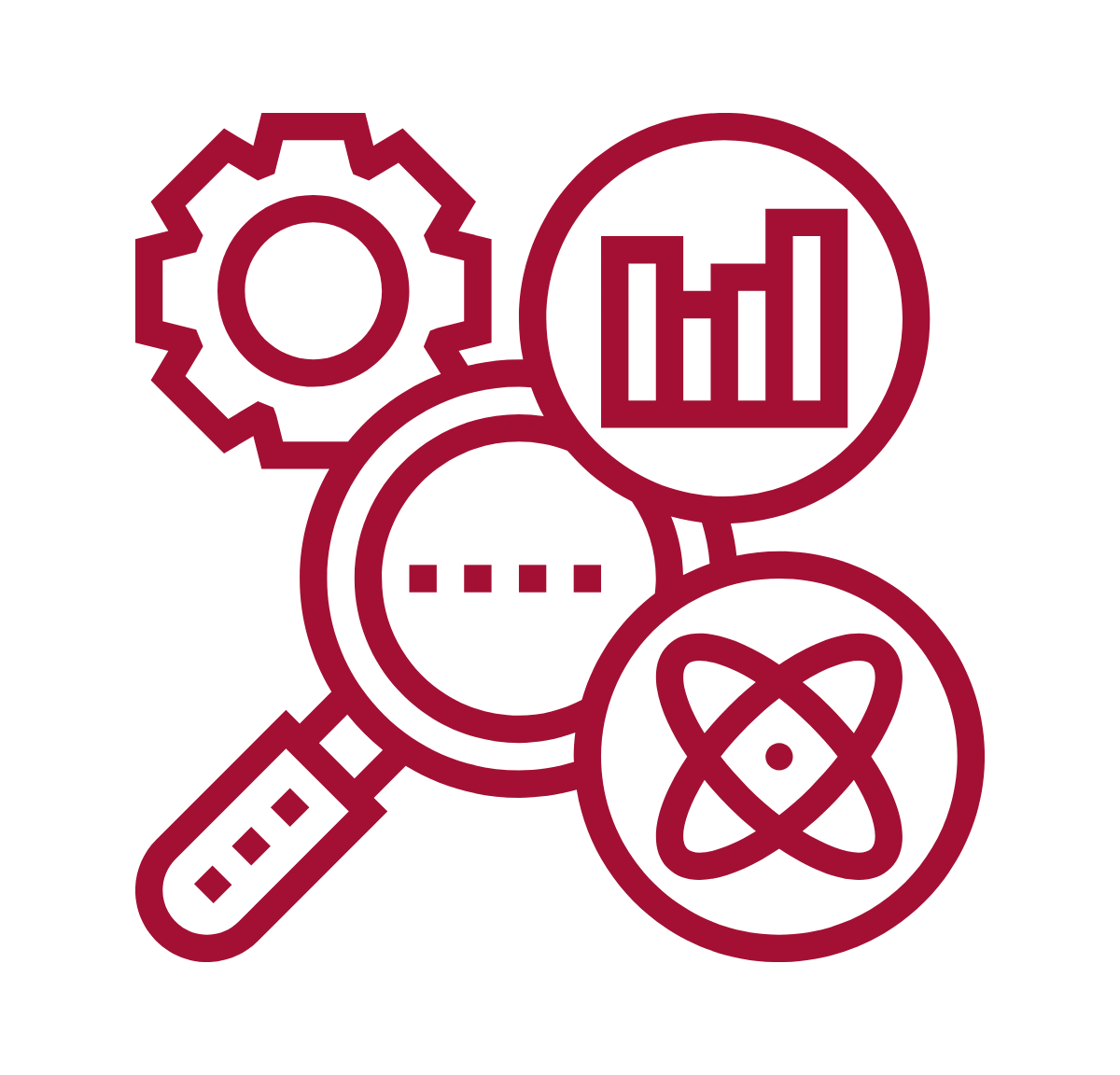
97 Harvard climate ventures incubated to date
Source: Learn more.
Harvard Climate Action Week
Launched in 2023 by the Salata Institute for Climate and Sustainability, Harvard Climate Action Week (HCAW) invites climate experts, leaders, and stakeholders to come together and explore solutions to the most complex and challenging dimensions of the climate crisis. HCAW 2024 was held June 10-14, 2024 and included events, in-person and online, that delved deep into the policies, private actions, and leadership needed to drive further reductions in U.S. greenhouse gas emissions.
Harvard Office for Sustainability at HCAW
Harvard Chief Sustainability Officer Heather Henriksen and Harvard Office for Sustainability Associate Director David Havelick spoke with faculty and experts on two panels at HCAW 2024. The Salata Institute hosted a reception, “Toasting Sustainability Solutions” at the Harvard Museum of Archaeology and Ethnology in partnership with the Office for Sustainability.
Updating Harvard’s Sustainability Action Plan
In 2023, Harvard released its updated Sustainability Action Plan. First adopted in 2014, this strategic roadmap is built around three pillars of climate, equity, and health, and offers a unifying and holistic vision for creating a more sustainable institution, and in turn a more sustainable world. Access to Harvard’s operational sustainability standards, created with faculty, students and staff, is open-source and available to the public.
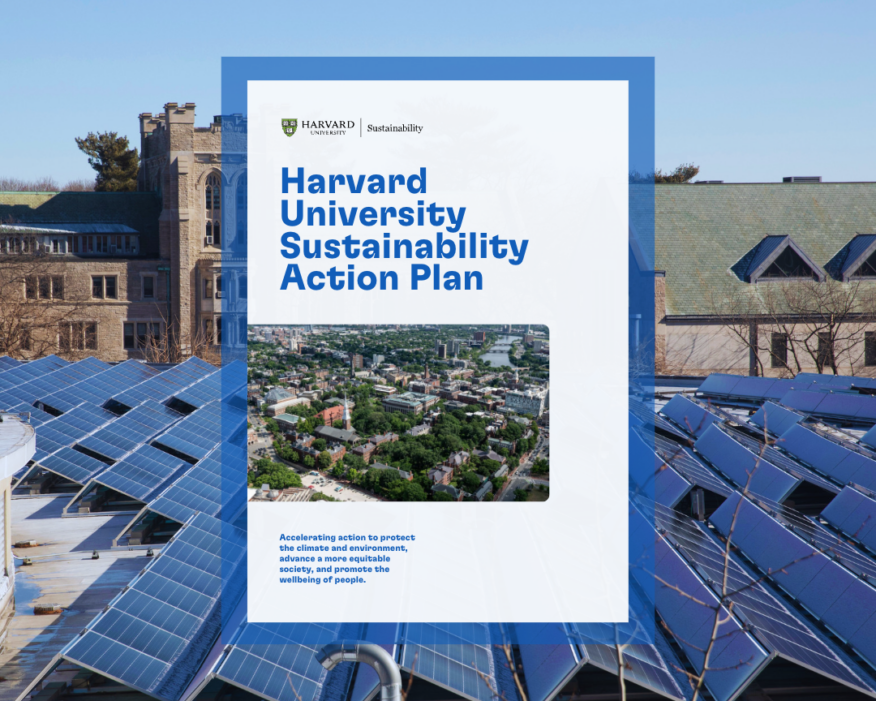
Leading & Collaborating at Harvard and beyond
Harvard i-Lab
Funding Innovative Climate Ventures
The Climate Entrepreneurs Circle through Harvard i-Lab is a selective incubation program for high-potential ventures working to address climate change. The Climate Circle has 97 Harvard-led ventures incubated to date, which tackle a wide array of global challenges. Venture topics include decarbonizing real estate, building predictive agriculture with AI-powered gene expression technology, scaling solar energy technology, climate finance, and much more.
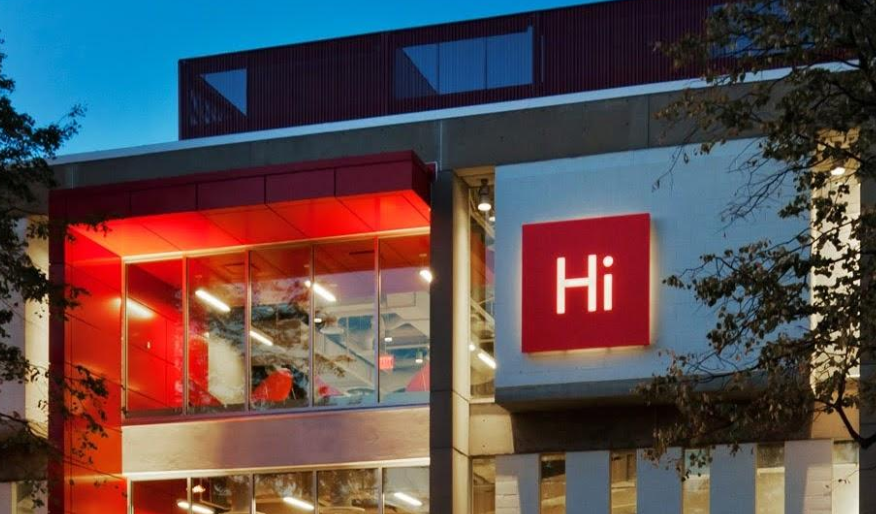
Engaging Students and the Community
Council of Student Sustainability Leaders
Managed by the Harvard Office for Sustainability, the Council of Sustainability Leaders (CSSL) comprises Harvard graduate and undergraduate students who lead sustainability-related student groups on campus. CSSL provides an opportunity for Harvard students to work together with other students from across the University’s Schools on sustainability projects, to connect and network with sustainability leaders (including students, faculty, and administration), and to provide feedback and recommendations on Harvard’s climate, health, equity, and sustainability initiatives.
Resource Efficiency Program (REP)
The Resource Efficiency Program (REP) is a peer-driven educational initiative at Harvard College dedicated to promoting sustainable living within undergraduate houses and dormitories. Student employees, i.e. “REPs”, engage their peers through events, competitions, and campaigns. REPs have a direct impact on campus sustainability goals, via operations-focused projects with tangible outcomes within their residence buildings and beyond.
Student Sustainability Grants
The Student Sustainability Grant program funds creative projects that contribute to Harvard’s commitment to climate, health and equity that help create a more sustainable community. Since the Office for Sustainability founded the Student Sustainability Grant program in 2010, more than 100 projects have been awarded with seed funding to support new student-driven ideas and innovative projects that address global sustainability challenges with on-campus applications.
Earth Day
The annual Harvard Earth Day event, hosted by the Harvard Office for Sustainability and Harvard Common Spaces, invites the campus community to get involved in sustainability. The most recent 2024 Earth Day event, held on campus on April 18, 2024, included a Freecycle event with free donated items, electronics recycling, bike repairs, tabling by campus organizations and groups, and more.
HU Longwood Earth Day Festival
The HU Longwood Earth Day Festival in April brought 350 people to Countway Community Garden, where they learned about sustainability, shared ideas, and built community with representatives from event sponsors Harvard T.H. Chan School of Public Health, Harvard Medical School, Harvard School of Dental Medicine, and Countway Library, in addition to members of HU student organizations, departments and institutes. Activities included rock painting, food samples, free plants, seeds, and coffee drinks, and sustainability-themed prizes.
Charles River Clean-Up
Hosted by the Harvard Kennedy School in collaboration with Harvard Office for Sustainability, Harvard Business School, Harvard Real Estate, and Harvard Recycling, the Charles River Clean-Up event, held on April 19, 2024, allowed Harvard community members and friends to help remove trash along the Charles River. The Charles River Conservancy provided a brief education on the local watershed, as well as tools and training for the clean-up. This annual event has had hosted more than 400 volunteers since it began in 2017.
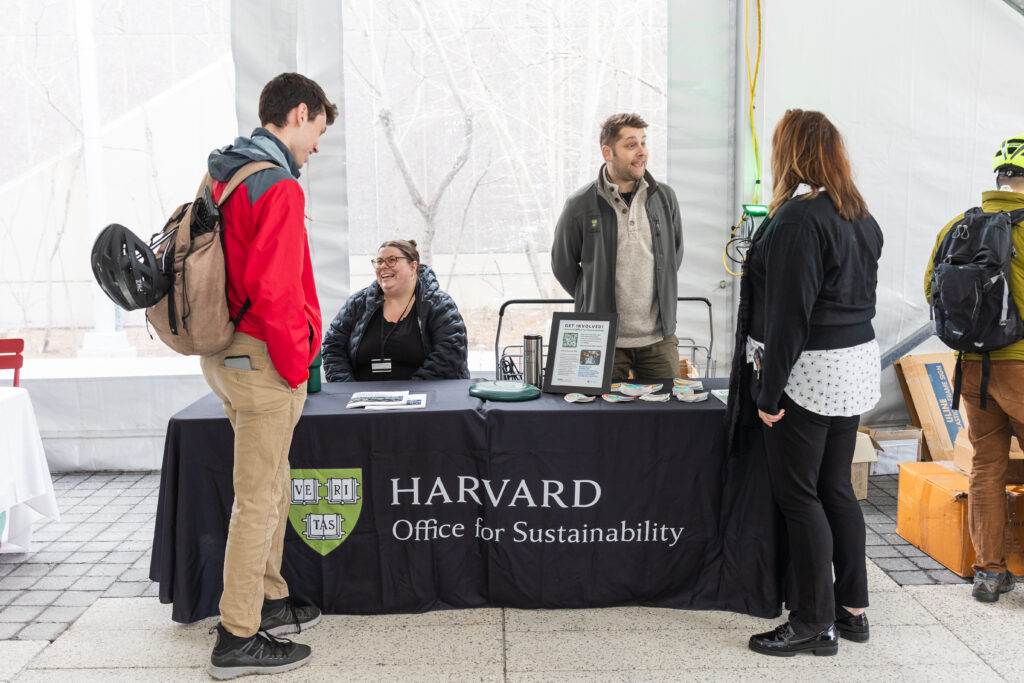
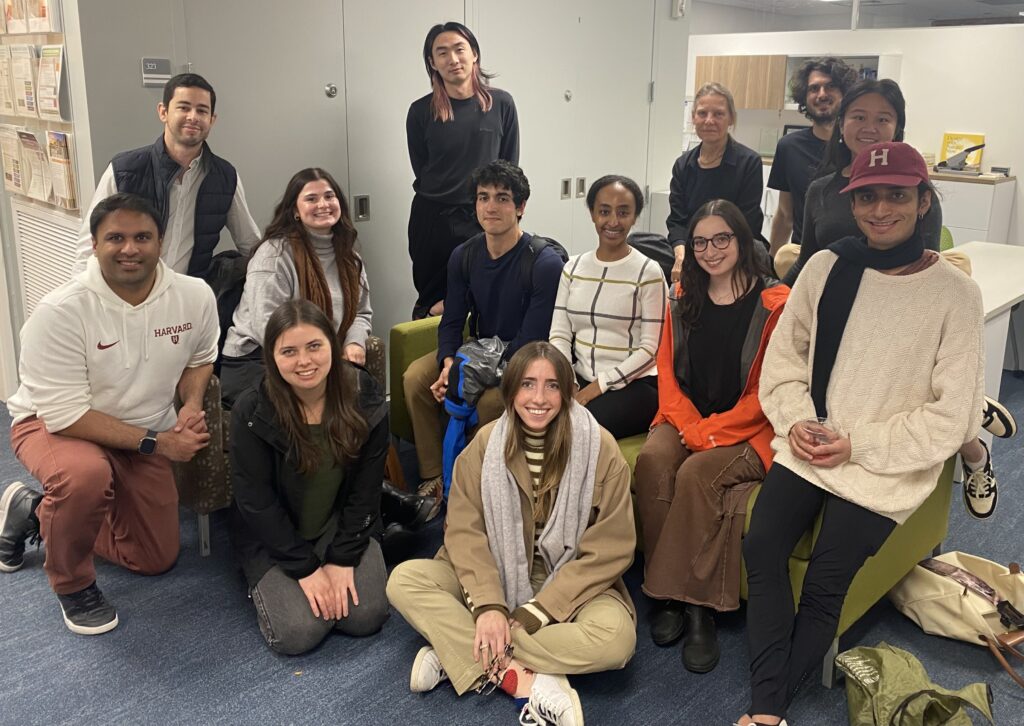
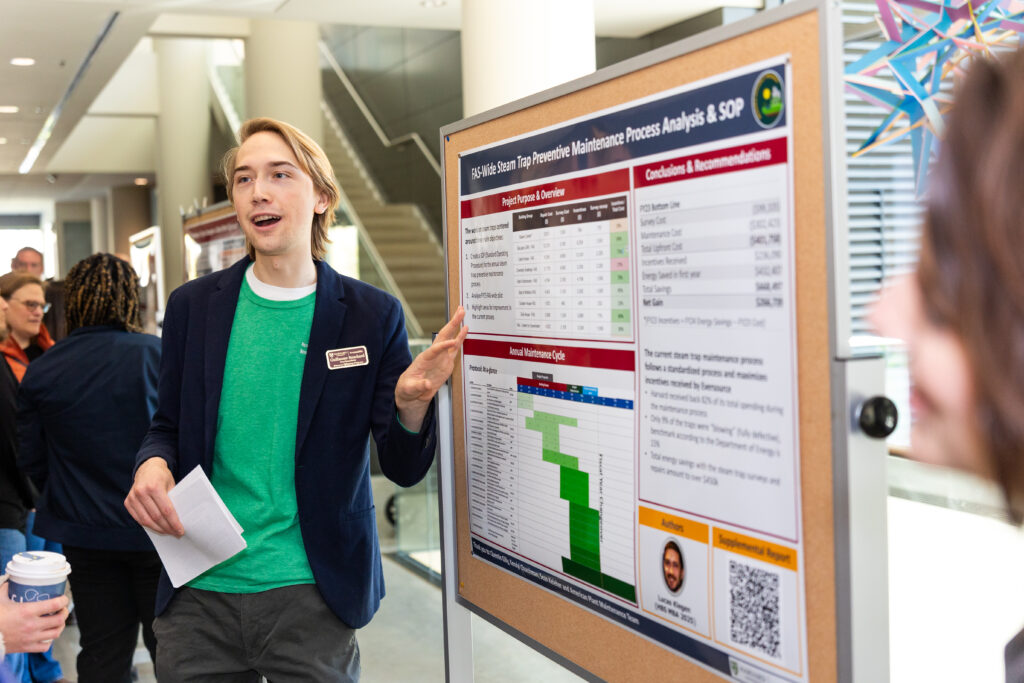
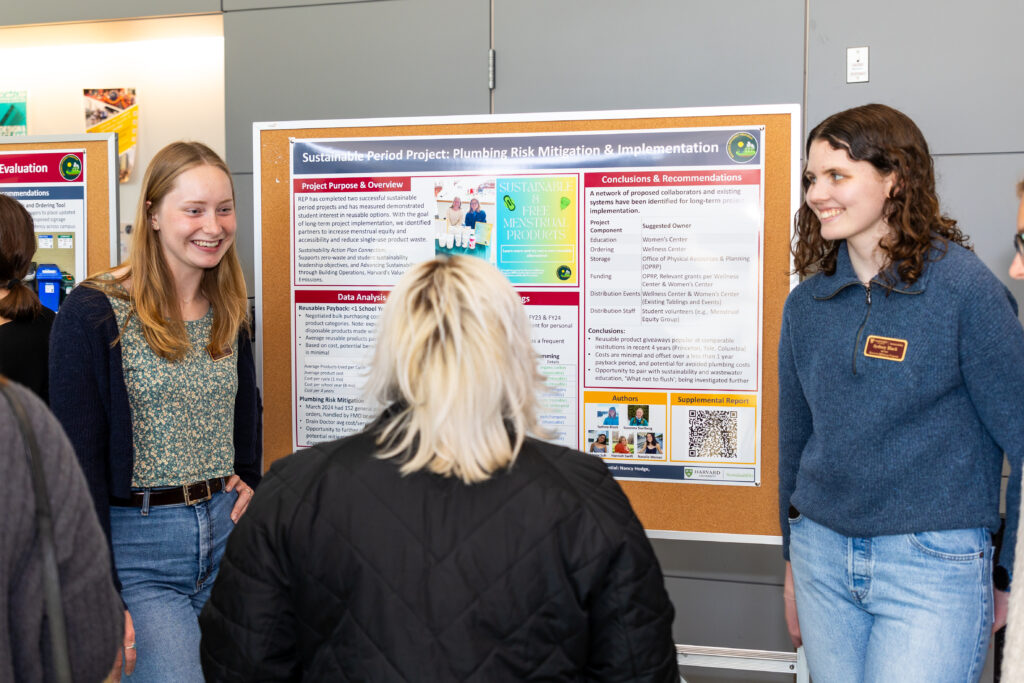
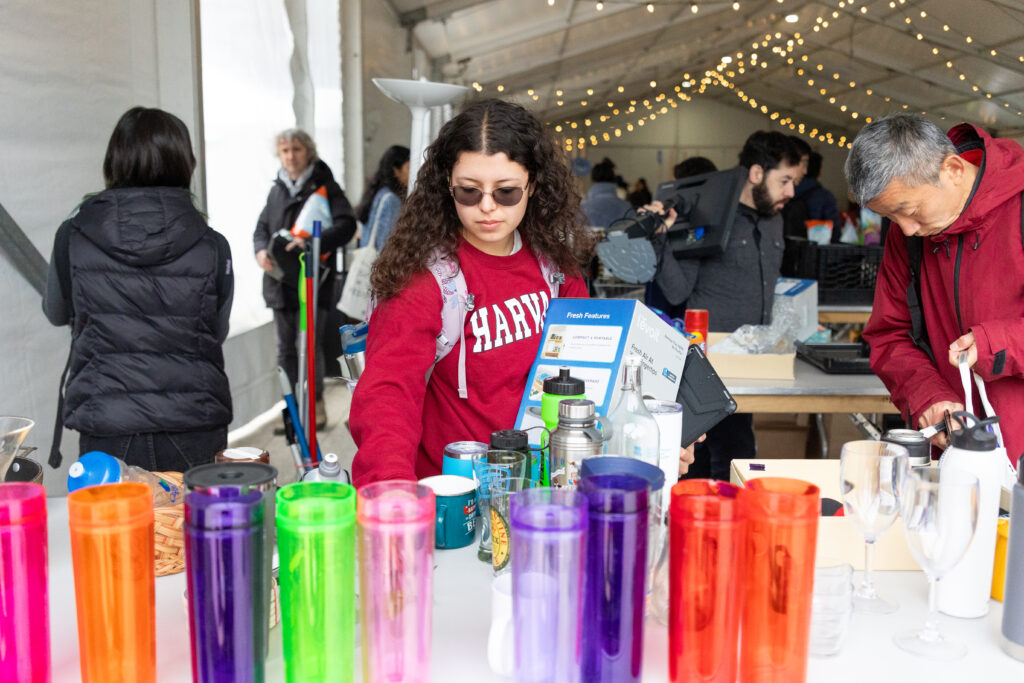
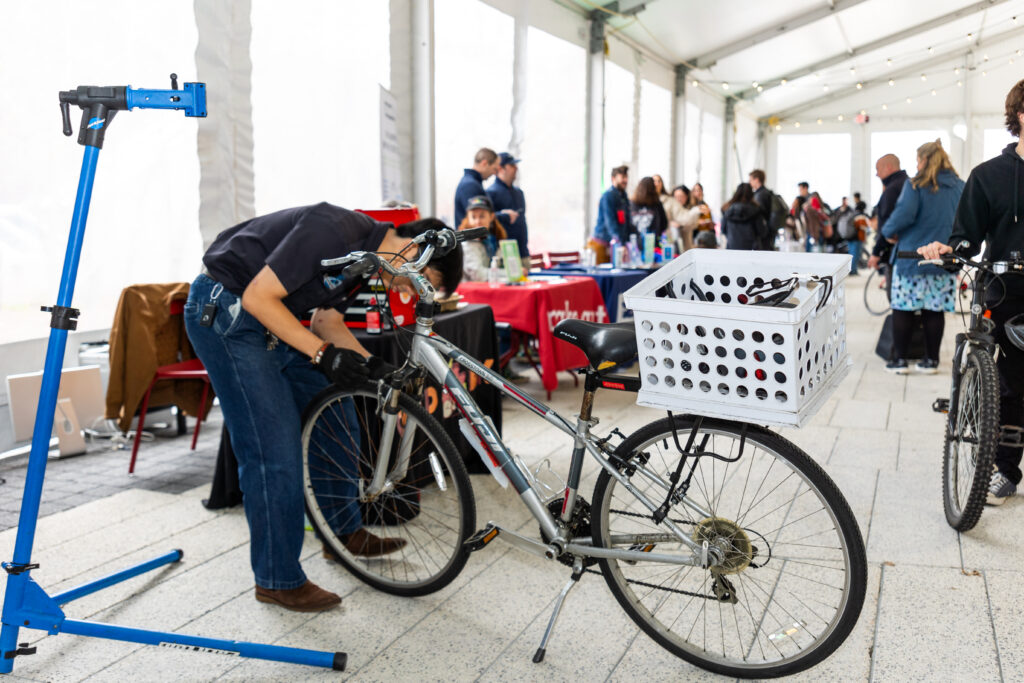
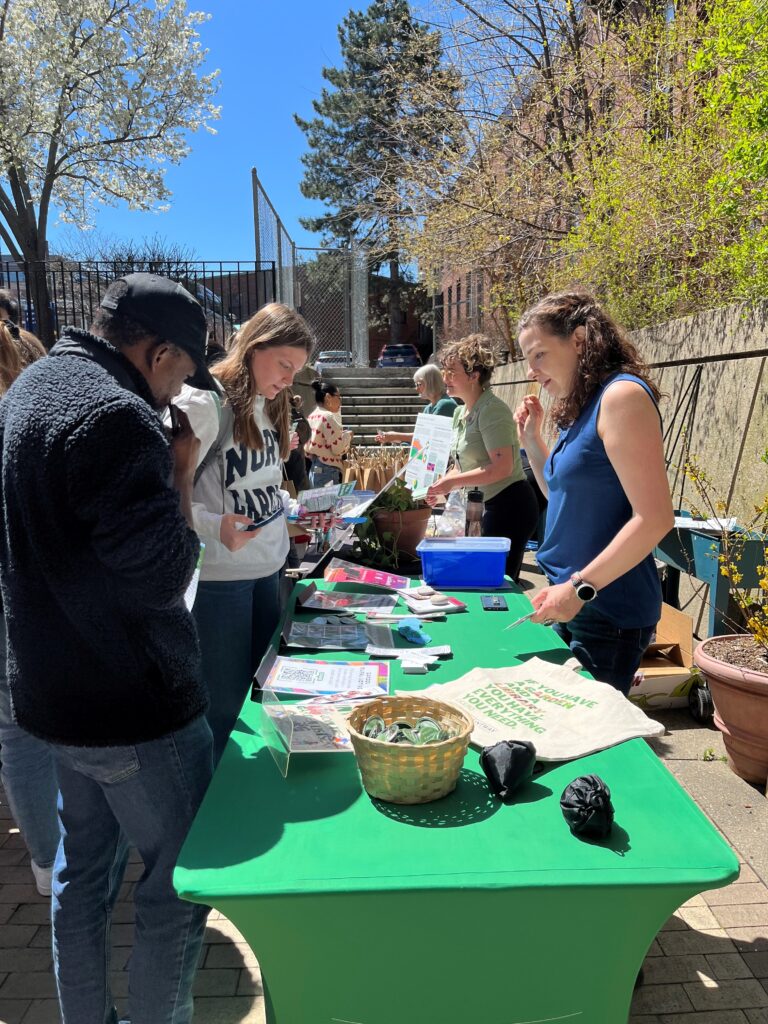
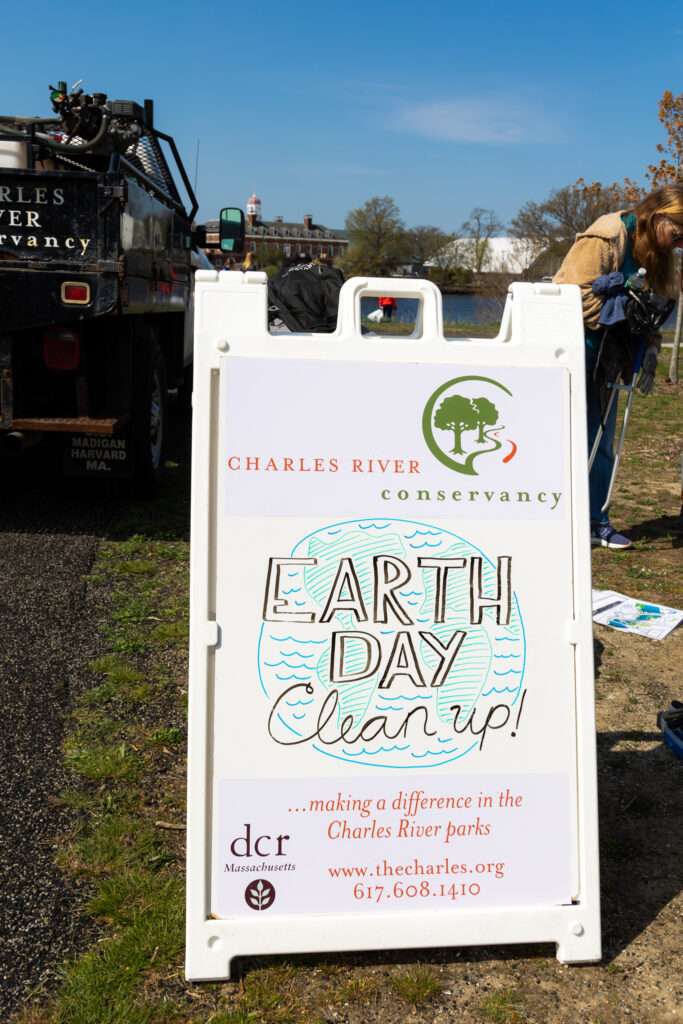
About the Harvard Sustainability Report
The 2023-2024 Harvard Sustainability Report was produced by the Harvard Office for Sustainability (OFS) to update our community on the University’s progress toward meeting the goals, standards, and commitments as described in the University’s Sustainability Action Plan. Data is collected from individual Harvard Schools, Units and aggregated and analyzed by OFS.
The Harvard Management Company reports on the University’s endowment. Harvard Financial Administration posts the Annual Financial Report. The Chief Diversity Officer reports on institutional diversity and equity. The Harvard Fact Book presents a wide range of data regarding the University’s organization, people, and resources.
View snapshots of past Annual Sustainability Reports:






















